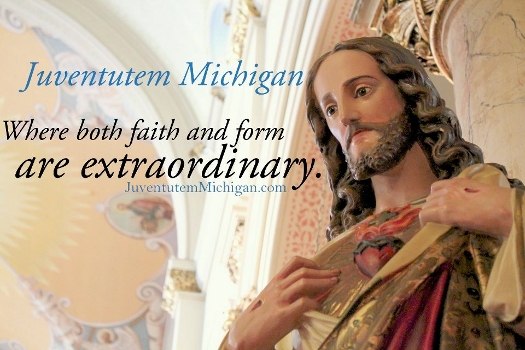
"I will go in unto the Altar of God
To God, Who giveth joy to my youth"
Tridentine Community News (May 4, 2014):

We welcome a brand new community to the readership of the Tridentine Community News: The Oakland County Latin Mass Association, which today begins weekly Sunday Masses at 9:45 AM at the Chapel of the Academy of the Sacred Heart in Bloomfield Hills, Michigan. Some background is in order for our new readers, both at the Academy and elsewhere:
The Traditional Latin Mass was the norm for worship in the Roman Rite of the Catholic Church until 1965, when a transitional missal was imposed. The term “Tridentine” is an adjective relating to the Council of Trent, at which the classic form of Mass was codified. In 1970, after Vatican II, a major revision of the Roman Missal, commonly known as the “Novus Ordo”, was made the new norm. While most Catholics accepted the new missal with obedience, a small but highly motivated number of people across the globe began to request that the former missal be permitted as an option. Only one year later, in 1971, Pope Paul VI allowed the Tridentine Mass to be celebrated once again in England and Wales, via a document which came to be known inform ally as the “Agatha Christie Indult”, after one of the more famous signatories to the petition. In 1984 permission was extended to the worldwide Church via a document entitled Quattuor Abhinc Annos. In 1988 Pope John Paul II gave further endorsement to the “legitimate aspirations” of those who preferred the Traditional Mass in the Motu Proprio, or papal order, Ecclésia Dei Adflícta.
From 1984-2006, the number of Tridentine Masses across the globe continued to expand, albeit at a restricted pace because the local bishop’s permission was required before the classic liturgy could be celebrated.
In 2007 Pope Emeritus Benedict XVI issued the landmark Motu Proprio,Summórum Pontíficum, which permitted any priest to celebrate the Tridentine Mass and all of the pre-Vatican II Sacraments without requiring the permission of the local bishop. This resulted in an explosion of Tridentine Masses; in the Archdiocese of Detroit, for example, the number of Mass sites surged from one to eleven in just a few years. In 2011, the Vatican issued a clarification document, Univérsæ Ecclésiæ, which reaffirmed Rome’s commitment to supporting those who prefer to worship according to the “Extraordinary Form”, Pope Emeritus Benedict’s term for the Tridentine Mass.
Originally it was thought that the revival of the traditional liturgy would appeal primarily to those who grew up with it – the older generation. As it turns out, much of the demand actually comes from the young. Here in metro Detroit and Windsor, for example, the local chapter of the international young adult organization Juventútem organizes a continual stream of special Latin Masses and spiritual and social events. Indeed, the “Juventúters” have brought the Traditional Mass back to several of Detroit’s historic churches for the first time in over 40 years, including Blessed Sacrament Cathedral.
So what is it about this Mass that appeals to so many?The creation of this weekly column was requested in 2006 by Fr. Mark Borkowski, who co-founded the Tridentine Mass at Detroit’s St. Josaphat Church. Its mission is to relay local, national, and international news and information about Sacred Tradition, along with liturgical topics and explanations, and a weekly schedule of local Latin Masses taking place. Regular Sunday Masses are not included in the schedule, since people picking up this column presumably already know about those. The Tridentine Community News is distributed at a number of locations, including the St. Benedict Tridentine Community at Assumption Church in Windsor, the original Latin Mass group in this region; and at the Tridentine Masses held at St. Albertus, St. Hyacinth, and Holy Redeemer Churches in Detroit. All back issues of the column are posted on the St. Benedict web site, www.windsorlatinmass.org. The Tridentine Community News has recently spawned a television series covering much the same material: Extraordinary Faith, airing on EWTN and produced by this author.
- The knowledge that one is participating in a reverent form of worship that nurtured the faith of countless saints and martyrs, along with one’s ancestors.
- Hearing and singing Gregorian Chant, Sacred Polyphony (music for multiple vocal parts), and traditional hymns written according to timeless norms and employing sacred texts.
- Appreciation for the elaborate and clearly Catholic texts in the Mass, in the blessings and Sacraments found in the traditional Roman Ritual, and in traditional devotions such as Benediction.
- Being able to engage in “active participation” in the Mass according to the definition given by Holy Mother Church: full, conscious engagement of the mind and soul in prayer.
- Witnessing the architectural features and sacred objects and art of a classically-designed church being put to the uses for which they were intended: An elevated High Altar at which the priest leads the congregation in prayer, facing God in the tabernacle along with the people; a Communion Rail at which to receive the Blessed Sacrament in the classically reverent posture of kneeling; a pipe organ, devotional shrines, and ornate vestments.
We invite all of our new readers to learn more about the Extraordinary Form of Holy Mass, both via this column and via the abundant books and Internet resources now available. You are participating in a worldwide resurgence of interest in classic worship – an exciting time to be Catholic.
-Alex Begin, Editor, Tridentine Community News
Tridentine Masses This Coming Week
- Mon. 05/05 7:00 PM: Low Mass at St. Joseph (St. Pius V, Pope & Confessor)
- Tue. 05/06 7:00 PM: Low Mass at St. Benedict/Assumption-Windsor (St. John Before the Latin Gate)


No comments:
Post a Comment